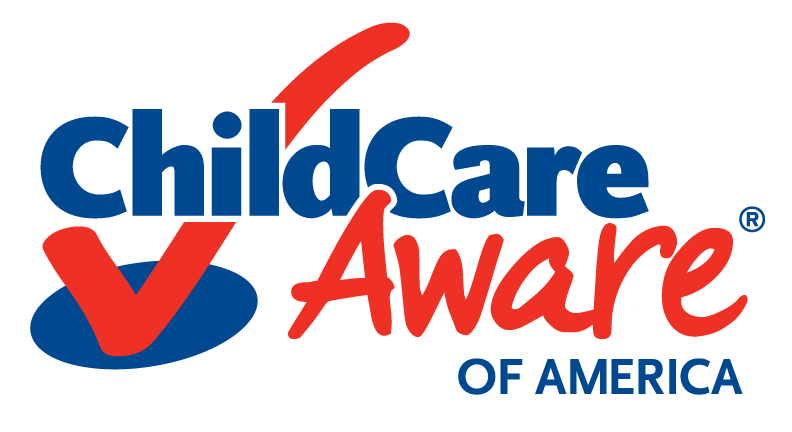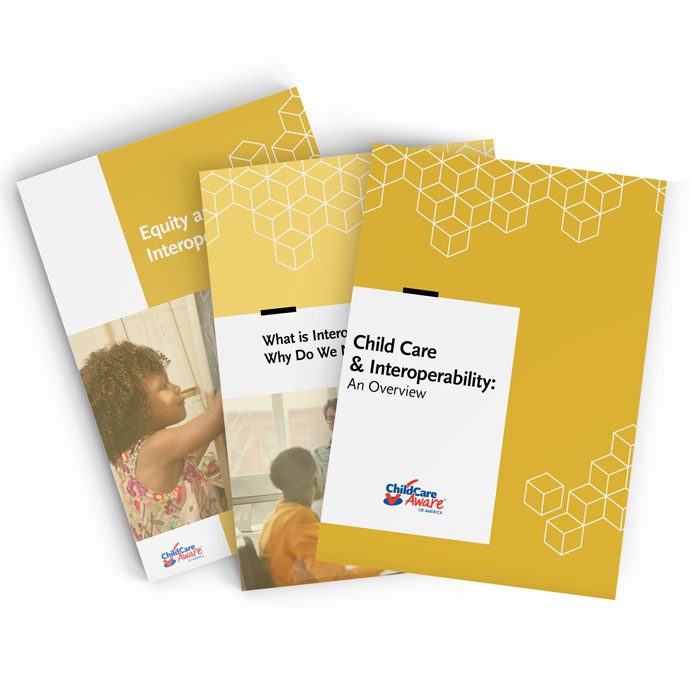Child Care Data Center & State Fact Sheets
We all know that 2020 was an extremely difficult year for the child care system. The COVID-19 pandemic intensified the already familiar strains on child care providers and families. Our previous work found that providers were leaving the field prior to the pandemic. When child care providers had to close or experienced massive drops in attendance due to COVID-19, their ability to stay in business was further threatened.
In our 2020 annual survey, Child Care Aware® of America (CCAoA) included questions to gauge the effects of COVID-19 on states’ child care systems. This year, we offer the state-level data in two different formats. You can see dynamic visualizations by clicking on states in the map below or view simplified tables in our 2021 State Fact Sheets PDF.
The 2021 State Fact Sheets are part of CCAoA’s collection of downloadable Resources (“Works”) and are subject to the Site Terms of CCAoA’s Website. CCAoA retains all right, title and interest in and to such Works and Users must use the Works as provided in full.
Please note that some states were unable to meet our original survey deadline and requested extensions. These states appear dark and unclickable on the map below. We will add their information as soon as we receive and verify it. The additional responses may also change some of the information summarized in the overview below.
We also released our highly anticipated Child Care Data Center (CCDC) in late 2020. The CCDC focuses on state and county-level data about child care affordability, accessibility and environmental risk within our six pilot states: Illinois, Minnesota, Missouri, Oregon, Washington and Wisconsin. Click the Child Care Data Center tab at the top of the map to explore this project data.

Methodology
The information found in the state fact sheets comes from a variety of sources. In January 2021, CCAoA surveyed state Child Care Resource and Referral (CCR&R) agencies or other key child care stakeholders in each state. The survey covered the following topics: child care supply and capacity, quality rating and improvement systems (QRIS), CCR&R services, child care initiatives and annual child care prices. Child care price data will be released by CCAoA in September 2021. Respondents were asked to complete the survey based on data as of December 2020.
We did not include categories if the state did not report these numbers in our annual survey. Child care supply and QRIS data were gathered from public databases for: Alabama, Kentucky, Mississippi, New Jersey, Pennsylvania, Puerto Rico, Rhode Island, South Carolina, Texas and Wyoming. For more information, please contact us at research@usa.childcareaware.org.
Child Care Supply and Utilization
In 2020, we conducted two brief surveys in addition to our annual survey. We asked states to record the number of open child care centers and family child care (FCC) homes as of July 2020 and December 2020. These survey findings were published in our Picking Up the Pieces report in September 2020. We also posted a follow-up blog in February 2021. As of July 2020, 35% of centers and 27% of FCCs were closed. These numbers fell dramatically by December 2020 – with only 10% of centers and 10% of FCCs remaining closed.
Although the numbers seem to indicate that child care providers are recovering, there is evidence that attendance and enrollment have not recovered as well. An analysis of weekly data throughout 2020 from Early Learning Ventures (ELV), a shared services platform in Colorado, found that by December 2020 attendance among center-based ELV providers was 21% below what it was at the start of the year. Other researchers have found similar findings. The Center for American Progress found that attendance dropped 52% below pre-COVID levels in a sample of Colorado-based providers. A survey of child care providers conducted in December 2020 by the National Association for the Education of Young Children (NAEYC) found that only around 68% of children were attending compared to pre-COVID attendance. Reopening child care programs is only one component of recovery. Many providers are struggling to stay in business and may not be able to last much longer without increased attendance and financial assistance.
There are also concerns about the number of child care providers who have closed their doors permanently. In this year’s annual survey, 15 states indicated that they were tracking the number of permanent child care closures. On average, these states reported that 3% of centers and 4% of FCC providers were closed, compared to supply numbers from December 2019. We anticipate that the number of permanent closures will increase as states and CCR&Rs update their licensing and referral information.
As the prospects for earning a living as a child care provider grow more remote, the child care workforce declines. The Hechinger Report noted that 166,800 fewer people were working in the child care field when they compared federal data from December 2019 to December 2020. CCR&R agencies have also noticed a decline in the child care workforce. Anecdotally, several CCR&R leaders from around the country stated that one reason for decreased child care attendance is due to the inability of programs to find qualified staff. This crisis is expected to grow as COVID-19 restrictions are lifted and parents work outside the home in greater numbers. A survey of child care business owners conducted by Early Learning New Hampshire found that they could accommodate over 2,000 more children if they could hire enough staff. As the economy recovers from the COVID-19 pandemic and more parents return to work, it will be more difficult than ever to find the child care that they need.
The Role of CCR&Rs
Throughout the COVID-19 pandemic, CCR&Rs across the country have worked tirelessly to assist families and child care providers. In May 2020, we surveyed CCR&RS to understand their responses to the pandemic. Overall, we found that CCR&Rs were doing numerous activities to assist their communities.
Almost one year after this survey was completed, we found that CCR&Rs continue to fill a need in their communities. In our annual survey, we asked a series of questions about CCR&R services during the pandemic. CCR&Rs are assisting in the following ways:
- Financial assistance (50%) – This includes purchasing PPE and cleaning supplies for child care providers and distributing grant money to help them stay afloat.
- Training (63%) – This includes educating providers about recommendations from the Centers for Disease Control related to child care and how to navigate the various changes to licensing requirements (?) and ratios.
- Technical assistance (83%) – Helping providers make adjustments to their operations to keep everyone safe and comply with new licensing rules.
- Other services (50%) – Offering other services such as mental health support, informing providers about grant opportunities and updating websites to include information about COVID-19.
Policy Recommendations
Although 2020 was a stressful year for children, parents and child care providers, there remains hope that the child care system can be reimagined. Over the past year, we have seen historic investment in child care. With the passage of three COVID-19 relief packages, the federal government provided over $50 billion in dedicated relief funds to the child care sector. The most recent package, the American Rescue Plan Act, includes $39 billion for child care stabilization efforts.
The federal relief funds will help stabilize the sector, but focus must now shift to also building a transformed child care system that is affordable, accessible, equitable and provides children the healthy start they need. The child care sector was broken long before COVID-19. It is not sufficient to restore the sector to where it was prior to the pandemic. The child care system needs reform and robust long-term investment to address its long-standing fractures.
CCAoA recommends federal and state policymakers ensure relief funds are used in ways that build a better child care system. Policymakers should prioritize the following policies:
-
Workforce Support
Federal policymakers should support increased wages for the child care workerforce and ensure that all child care workers are paid a living wage and earn wages comparable to elementary school teachers with similar credentials and experience. Additionally, increasing funding to CCR&Rs will allow for expanded provider recruitment, retention, training and professional development for the workforce.
States have a great deal of flexibility in how they use their federal relief funds, and one of the most effective ways they can support the child care workforce is by raising wages or providing bonus pay. States can also use federal relief funds to invest in professional development opportunities or train child care educators.
-
Supply Building
Federal policymakers should consider providing grants to cover start-up and licensing costs to help establish new providers. There should also be designated federal funding streams for the construction and renovation of child care facilities.
With their federal relief dollars, state policymakers should consider additional stabilization grants to help cover necessary sanitation equipment and supplies, utilities and rent and lost revenue to help providers cover bills and resume operations. States can help build supply by increasing reimbursement rates to reflect the cost of high-quality care and basing subsidy payments on monthly enrollment, not attendance, or creating more contracts and grants for subsidy slots. These approaches ensure providers can cover fixed costs when attendance fluctuates.
-
Data Infrastructure
Improving the infrastructure of child care will require investments in data and digital technology. These investments would ensure families have access to real-time data about supply, system leaders understand the implications of policies and practices and providers can successfully manage their businesses. Federal policymakers should provide funding for states to establish integrated data networks for all early childhood programs. Having a strong data system will help build a better child care system. States may use federal relief funds to make upgrades to data collection and technology systems and should consider doing so.
Additional Resources
Learn More about Child Care Data
Anyone who works in the child care field knows how difficult it is to find data – and even more difficult to standardize it. That’s why CCAoA built a tool to standardize and visualize child care data across states. If you are a part of a state-level organization and want to be a part of the Child Care Data Center — or, if you’re interested in how child care data can be streamlined in an interoperable child care system — please fill out the form below.







